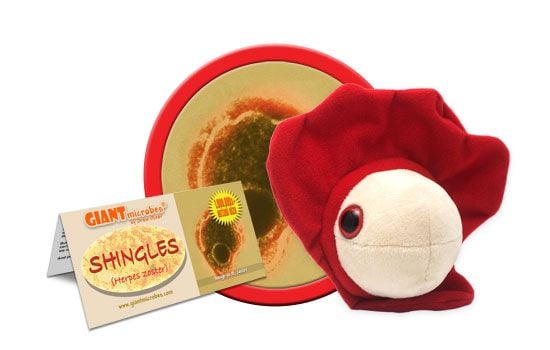Shingles (Herpes zoster)
Out of Stock
Product Details
Additional Information
| Sizes | Giantmicrobes are based on actual microbes, cells, organisms and other critters, only 1,000,000 times actual size! Gigantic (GG) 16-24" XL (XL) 10-15" Original (PD) 5-8" Keychain (KC) 2-4" with clip |
|---|---|
| Materials | Plush from all new materials. Stuffed with polyester fiber fill. Surface washable: sponge with water & soap, air dry. |
| Packaging | Each plush microbe includes a printed card with fun, educational and fascinating facts about the actual microbe or cell. Themed Gift boxes and Holiday boxes are also available. |
| Safety | Every product meets or exceeds U.S. and European standards for safety. For ages 3 and up. |
All about Shingles (Herpes zoster)
FACTS: Shingles, aka Herpes zoster, is a blistery skin rash which typically manifests itself as stripes or splotches on the face or wrapped around on one side of the body. The name shingles is a corruption of the Latin word cingulum, or girdle, after its characteristic appearance.
Chickenpox is the primary handiwork of the Herpes zoster virus. But after the virus has been routed, it remains dormant in the nerve cell bodies, or satellite cells. Years or even decades later it can activate and spread along a specific nerve pathway, affecting all the areas governed by that spinal nerve.
It is most prevalent in people over 50, particularly among those with immune systems compromised by disease, stress, or even certain medications. Early symptoms include headaches and fevers, as well as itching in the affected areas. (Outbreaks near the eyes can cause additional complications.)
Shingles normally self-resolves after 2 – 4 weeks, though symptoms can linger for much longer. (Where postherpetic neuraligia is evident, pain can continue for years.)
But fortunately, a zoster vaccine is now available which is substantially effective against both the initial chickenpox infection and shingles outbreaks. So in many parts of the world, the decision to play host to the virus is now to a certain degree discretionary.
Nevertheless, should it occur, antiviral treatments are also available which can mitigate the impact of shingles, reducing recovery time and limiting the severity of the rash.
| Name | It was named after the symptoms it causes. Varicella comes from the Latin root “variola” that mean “speckled or spotted”. Zoster means “girdle” in Greek and describes the body rash from shingles. |
|---|
| Actual Size | 120 to 300 nanometers – that’s 100 thousand times smaller than a skittle! |
|---|
| Where It Lives | Shingles is a common disease caused by Varicella-Zoster virus, or VZV. It’s the same virus that causes chicken pox and at least 90% of people in the U.S. have been exposed to it! Shingles can only develop from reactivation of VZV after a person has had chicken pox. The virus spreads from person to person by coughing or sneezing. |
|---|
| Symptoms | It’s a painful, itchy rash that usually develops on one side of the face or body. IT causes blisters that can burst and spread the virus further. Some people may also have fever, headaches, chills, or tummy aches. |
|---|
| Cure | Antivirals are available to treat it, but vaccines are recommended to prevent it. |
|---|
| History | Hungarian pediatrician, James Bokay, was the first to document the relationship between shingles and chicken pox in 1892. |
|---|
| Fascinating Facts | It’s a common myth that only old people get shingles. Shingles can happen to young people and even children when their immune systems are weakened by another illness. |
|---|






